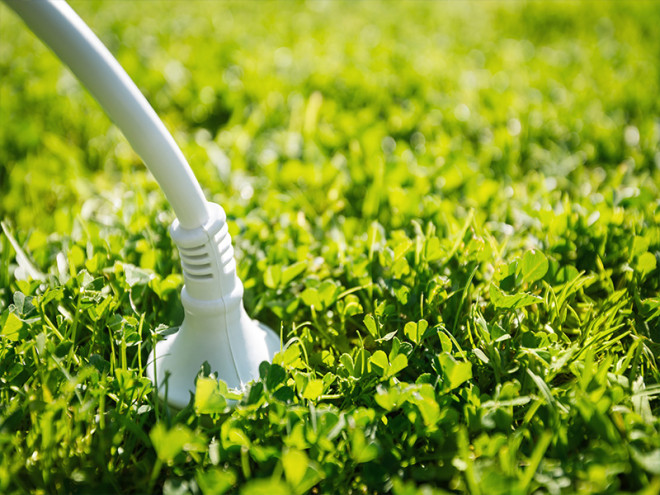Using what may well be the greenest of all green energy, Dutch company Plant-e is developing novel applications using the power of photosynthesis to create electricity. That’s right, Electricity from Plants: living plants literally lighting up the alternative power scene in some really neat ways.
In November of 2014, Plant-e launched their modular plant systems to power an artistic display of more than 300 LED light bulbs in both Zaandam and Ede-Wageningen in the Netherlands. The project is called “Starry Sky” and is the company’s first commercial installation of their emerging technology. In addition to powering lighting, Plant-e has created Wi-Fi hot spots, mobile chargers, and rooftop electricity modules using the same process.
Electricity from Plants – a Vision:
The company’s co-founder and CEO, Marjolein Helder, first began studying plant energy and the idea of harnessing electricity from plants when she was working on her master’s thesis in environmental technology at Wageningen University. But it wasn’t until she began formulating a business plan for what would become Plant-e that Helder was able to combine her field of study with her desire to become an entrepreneur.
She believes that this technology could be revolutionary particularly as the company seeks to extend its use in existing wetland and rice paddies to generate electricity from plants on a larger scale, potentially powering some of the world’s poorest areas. Harnessing energy produced by photosynthesis may not be new, but Plant-e is the first to evolve the technology such that plants are not damaged during the process.
The technology used to power up the lighting exhibits in the Netherlands is based on modules of aquatic plants, that is, two-square-foot, interconnected, plastic containers with plants that are native to the area. When the plants undergo photosynthesis, whereby sunlight, air, and water are converted to sugars, the plants use energy from the sugar to grow, but end up discharging a large amount back into the soil as waste. The soil introduces bacteria, which helps to break down the sugar and, as a result, protons and electrons are produced. Electrodes collect the electrons produced, which are then transferred to a power harvester.
According to Helder, once the technology is refined for maximal output based on experiments and calculations, one-square-meter garden should produce 28 kilowatt-hours per year. Once the potential of the technology is fully realized, 100 m2 of Plant-e system will be able to meet 80% of the energy demand required for an average Dutch home (based on 3500 kWh electricity use per year). Naturally, energy yields using this technology vary by climate, with production stopping during periods when the ground is frozen.
What we can power with Plant Electricity:
Currently, Plant-e suggests their modular units are suitable for small to medium scale applications, ideally powering LED lighting, Wi-Fi spots, or generating electricity for buildings through installation of a green roof. As an added bonus, a plant module-covered roof can also provide insulation, water storage and increase biodiversity. In addition to fine-tuning the modular units for home power, Plant-e has plans for larger scale applications it hopes to make a reality in the near future.
Using a tubular system, the company hopes to install the technology in larger wetland areas, such as peat bog, mangroves, rice paddies, and delta areas. The general principles and technology behind the tubular system would be the same as the modular unit, but the benefit of the tubular system is its ability to be scaled up for greater production. Helder explains:
“Modular systems are interesting, but you can only scale up to a certain size because it’s pretty labour- and material-intensive. A tubular system can just be rolled out through the field and it just works because the plants are already there. So for the longer term, for the really large scale, that’s much more interesting.”
According to Plant-e’s website, the company aims to have its first market-ready tube system in 2017/2018. In the meantime, however, if you are interested in seeing the technology in action, Plant-e does sell DIY boxes for educational purposes or you can purchase a kit to use at home that will power an LED light. While we may be a long way from 100% plant-based electricity powering our everyday lives, it’s wonderful to see progress happening in energy alternatives, especially those rooted in nature’s own splendid power. Electricity from plants – it’s possible!
About The Author

- Serial Entrepreneur, Technologist and Inventor my objective is to develop useful products that have a net positive effect in the lives of those that use them and the environment that we live in. CEO of Mission LED Lighting Company Ltd.
- 2017.12.27UncategorizedSaving the World and Saving Money: Green Home Improvements Every Homeowner Should Make
- 2017.01.17Be green & save5 Simple Green New Year Resolutions For 2017
- 2016.11.09LED factsReplacing a 400 HID Lamp for an LED
- 2016.09.26Be green & saveVintage LED Bulbs Make What’s Old New Again





Leave a Reply